 Visiting a dentist and dental treatment are an integral part of a person's life. Many face such a problem as the loss of one or more teeth.
Visiting a dentist and dental treatment are an integral part of a person's life. Many face such a problem as the loss of one or more teeth.
This is an extremely uncomfortable situation, since the load of chewing food is not properly distributed to the remaining teeth, resulting in unbearable pain.
Also due to incomplete dentition, bite problems may occur. And of course, the lack of teeth is quite a non-aesthetic picture.
The dentition can be restored by several methods:
- tooth implant;
- crown installation;
- bridge installation.
Contents
- Installation of the implant: features, minuses and pluses
- Recommendations for the care of implants
- Dental crowns
- Dental bridges
- Manufacture and installation of bridges and crowns
- How long will crowns and dental bridges last?
- The question remains open - what to choose for you?
- The conclusion in the theory is simple, in practice it is complicated. ..
Implant installation: features, minuses and pluses
The most commonly used procedure is implantation. The essence of the procedure is that a prosthesis implant is implanted into the jaw bone tissue, which becomes a replacement for the missing tooth.
Implant is made of titanium, which is fully compatible with the human body. It is characterized by high strength and resistance to heavy loads. 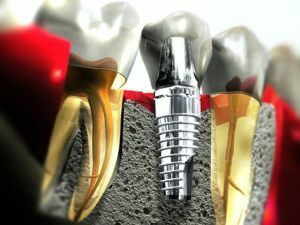
Plus implant is that when you install it there is no need to grind or modify adjacent teeth. Titanium tooth can be installed anywhere in the dentition. Even the functions of the toothless jaw can be restored through the implantation procedure.
Using this method will not only not touch the bone tissue, but also remove the excessive load from neighboring teeth that occurs during food intake. The implantation procedure is considered not painful and absolutely safe for the client.
The disadvantages can be attributed to the fact that part of the implant - the crown is not durable. And even with careful care, it will have to be replaced.
Recommendations for the care of implants
Lifestyle and care for artificial teeth affects their duration. Care should be taken with implants carefully and carefully. Especially careful to be in the postoperative period, when the mucosa is most vulnerable to infections.
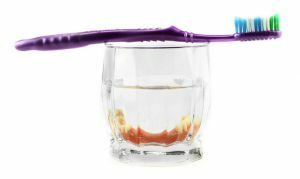 It is necessary to rinse the mouth and take prescribed medications. After this, the main rule of care is the maintenance of hygiene in the oral cavity.
It is necessary to rinse the mouth and take prescribed medications. After this, the main rule of care is the maintenance of hygiene in the oral cavity.
Proper cleaning with a toothbrush will help avoid plaque formation on the implant. To clean hard-to-reach places between the teeth, use special brushes, flosses and irrigators, which help in removing from the hard-to-reach areas of food residues.
Compliance with these standards of care will preserve the health of the oral cavity and prolong the life of artificial teeth.
Dental crowns
The installed crown completely covers the existing tooth. It not only strengthens the tooth, but also allows you to change its shape and appearance.
Also, the crowns are placed on the implant in order to recreate the shape of the tooth. Porcelain and ceramic crowns most accurately convey the shade of the dentition. Crowns made of gold, metal alloys, acrylic and ceramics are made.
Variants of alloys are most often used for teeth in the back row, as they are stronger than others.
In which cases the crown is used:
- if most of the tooth is damaged;
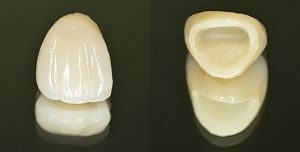
- for the protection of weakened teeth;
- for the purpose of regenerating a broken tooth;
- for attachment to the dental bridge;
- for covering a dental implant;
- to cover a damaged tooth or tooth that has lost pigmentation;
- after cleaning the root canal to cover the tooth.
The positive side of the crown is its tight prileganiya to the tooth. Also, crowns most aesthetically look in the dentition.
It's worth noting that you will need to get used to wearing a crown. And also in some cases, the metals used in the crown cause allergy in the patient.
Dental bridges
Bridges, also called dental bridges, are advised for installation in people who lack one or more teeth.
After the loss of more than one tooth in their place, a gap is formed, which sooner or later will lead to a change in the occlusion. 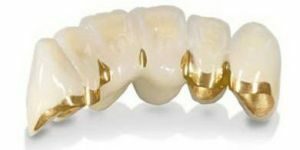 Violation of it can lead to gum disease and temporomandibular joint( TMJ).
Violation of it can lead to gum disease and temporomandibular joint( TMJ).
Most often such bridges are put on the replacement of one or a series of teeth. They fill an empty gap between the teeth. Bridges are installed to healthy teeth, or to pre-established implants.
The teeth on which the structure is attached are called supporting ones, the artificial teeth are called "the body of the bridge prosthesis" or, the Pontiac bridge, which is attached to the crowns that cover the supporting teeth.
Manufacture and installation of bridges and crowns
Before starting the installation of the crown, the doctor must reduce the size of the root, supporting tooth. This is done to ensure that the crown or dental bridge is secure and, most importantly, correctly secured.
After the artificial reduction of tooth size, the dentist makes a cast to create a crown or bridge. In case of using porcelain or ceramics, the dentist determines the exact shade of the prosthesis, identical to the teeth of the client.
On the finished impression, on the special equipment a prosthesis made of the necessary material is made. Before installing a permanent crown or bridge, a temporary prosthesis is placed on the tooth.
After the time required for the manufacture of a permanent prosthesis, the temporary one is removed, and a permanent prosthesis is installed in its place.
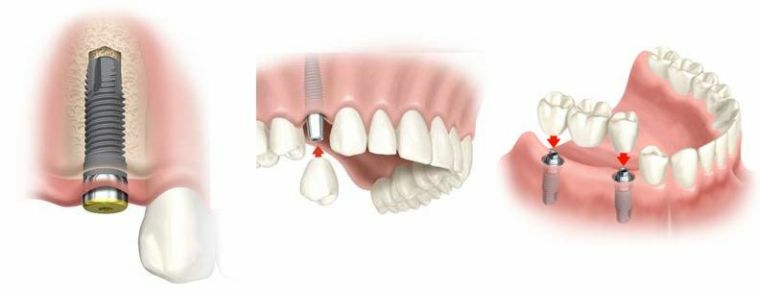
How long will crowns and dental bridges last?
The use of crowns and bridges is lifelong, however, due to incorrect care, dental prostheses often deteriorate and they have to be restored.
To protect them from falling out will help to follow the rules of hygiene and careful handling of artificial teeth. The bridge may lose support due to the occurrence of gum disease.
To protect yourself from damage to already installed crowns, implants or dental bridges, try not to get involved in solid food.
The question remains open - what to choose for you?
Reply to the question that the crown, bridge or implant is the best, it all depends on the specific situation. Some factors should be used to select the required dental implant procedure:
- Bridges, unlike crowns, can not be removed. Therefore, the crown is more hygienic for the , as it is to be cleaned.
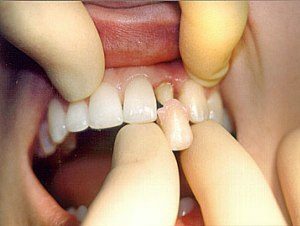
- Also bridge is much cheaper than implant .However, the bridge needs to be replaced after 5 years due to wear and tear. With an implant such problems do not arise.
- The crown is in the middle pricing policy of between the implant and the bridge.
- The implant installation does not require the involvement of adjacent teeth in the prosthesis process, whereas when installing the bridge it is impossible to avoid grinding even healthy, nearby teeth. In the case of restoration of a single tooth or several closely spaced, the implant placement is best suited. If the teeth that are next to the problems of the place are alive and there are no seals in them, then it is better to restore them with implants, since the procedure for depulsing the teeth can shorten the duration of their service.
- When installing a bridge prosthesis , the load on the jaw bone is disproportionately distributed, which can contribute to partial atrophy of bone tissue. Bridging is most suitable if the defect prevails in the supporting teeth.
- However, the implant is inferior to the installation of the bridge prosthesis in that some risks associated with the possible occurrence of complications in implantation are possible.
The conclusion in the theory is simple, in practice it is complicated. ..
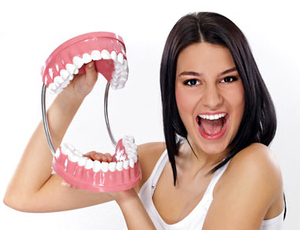 Depending on complexity and problems, material possibilities and aesthetic preferences, the patient can decide on the method of prosthetics, choosing between the bridge, implant and crown.
Depending on complexity and problems, material possibilities and aesthetic preferences, the patient can decide on the method of prosthetics, choosing between the bridge, implant and crown.
An alternative solution to the problem may be the introduction of two extreme implants, with the installation of a bridge restorative with support for implants after. Such a solution will save money, but will be no less reliable.
With the help of implants, it is recommended to restore the teeth in the event that the teeth that are extreme from the defect are alive. Due to the fact that turning and depulpation of supporting teeth will reduce their life span.
If they are susceptible to severe destruction and have defects, or are depulpated, then in such a situation the bridge prosthesis is best suited.
